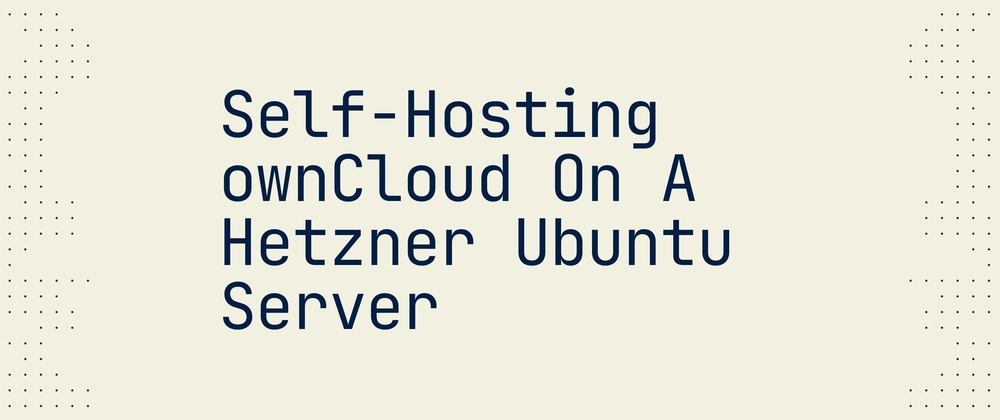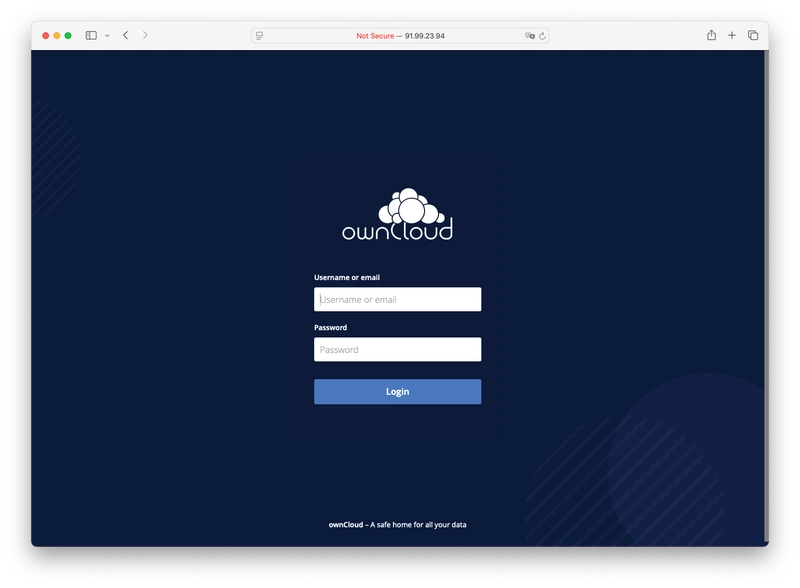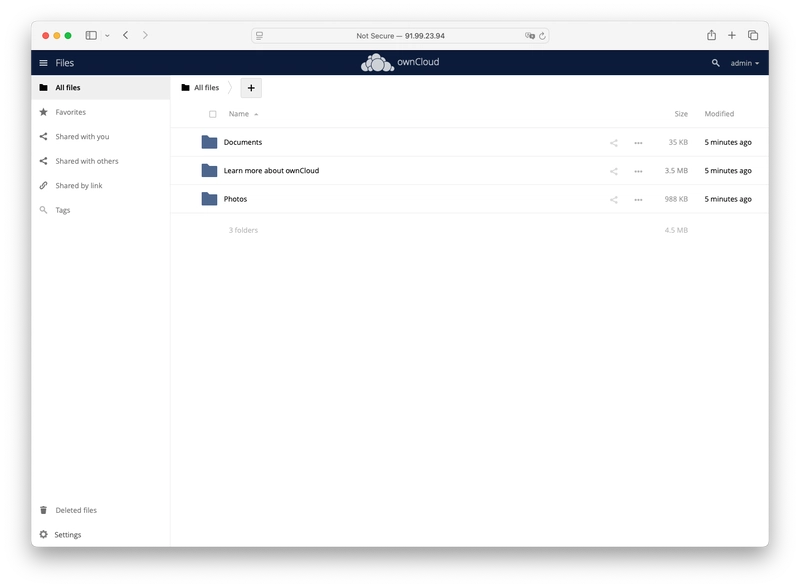Ever dreamed of having a cloud storage solution that YOU completely control, without relying on Dropbox or Google Drive? Let me introduce you to OwnCloud — an excellent open-source platform that enables you to host your own secure file storage system! 🚀 By setting up OwnCloud yourself, you regain control over your privacy, and in this guide, I'll walk you through the entire process using Docker on a Linux Ubuntu server.
Are you prepared to reclaim ownership of your data and reduce your dependence on big tech companies? :D
Step 1: Prepare Your Linux Server
For this tutorial, we'll be utilizing a cost-effective server from Hetzner, which has become one of my preferred providers for personal projects and small-scale self-hosting environments. Start by creating a Linux server instance. Ubuntu is a simple and reliable choice. Log into your server via SSH.
Once connected, ensure your system is current:
sudo apt-get update
sudo apt-get upgrade -y
Step 2: Setup a Firewall for Security
It is important to restrict the ports your server accepts connections on. Only the essential services (SSH on port 22, HTTP on port 80, and HTTPS on port 443) should be open:
sudo apt install ufw -y
sudo ufw allow 22 # SSH access
sudo ufw allow 80 # HTTP
sudo ufw allow 443 # HTTPS
sudo ufw enable
You can verify your rules are correct:
sudo ufw status verbose
Make sure that you also use the Firewall provided by your hosting provider, as Docker likes to circumvent UFW rules. Alternatively you can follow these steps from StackOverflow.
Step 3: Install Docker on Ubuntu Server
Docker is an easy tool to run applications inside isolated containers. Install Docker on Ubuntu by following these steps.
First, install the required packages and Docker's official GPG key so your system trusts Docker's packages:
sudo apt-get update
sudo apt-get install ca-certificates curl gnupg
sudo install -m 0755 -d /etc/apt/keyrings
curl -fsSL https://download.docker.com/linux/ubuntu/gpg | sudo gpg --dearmor -o /etc/apt/keyrings/docker.gpg
sudo chmod a+r /etc/apt/keyrings/docker.gpg
Then add Docker's official repository to your server:
echo \
"deb [arch=$(dpkg --print-architecture) signed-by=/etc/apt/keyrings/docker.gpg] https://download.docker.com/linux/ubuntu \
$(. /etc/os-release && echo $VERSION_CODENAME) stable" | \
sudo tee /etc/apt/sources.list.d/docker.list > /dev/null
sudo apt-get update
Now install Docker and Docker Compose Plugin:
sudo apt-get install docker-ce docker-ce-cli containerd.io docker-buildx-plugin docker-compose-plugin -y
Check that the Docker installation succeeded:
sudo docker run hello-world
Step 4: Setup Caddy Web Server to manage HTTPS
Caddy serves ownCloud securely by providing automatic HTTPS certificates. Install Caddy with these commands:
sudo apt install -y debian-keyring debian-archive-keyring apt-transport-https curl
curl -1sLf 'https://dl.cloudsmith.io/public/caddy/stable/gpg.key' | sudo gpg --dearmor -o /usr/share/keyrings/caddy-stable-archive-keyring.gpg
curl -1sLf 'https://dl.cloudsmith.io/public/caddy/stable/debian.deb.txt' \
| sudo tee /etc/apt/sources.list.d/caddy-stable.list
sudo apt update
sudo apt install caddy -y
Once installed, configure Caddy using a config file called Caddyfile:
sudo nano /etc/caddy/Caddyfile
Enter the following simple configuration in the file (use your registered domain name):
yourdomain.com {
reverse_proxy localhost:8000
}
If you haven't got a domain yet, temporarily use:
:80 {
reverse_proxy localhost:8000
}
Save the Caddyfile and restart Caddy:
sudo systemctl restart caddy
Step 5: Deploy Owncloud using Docker Compose
Create a directory for your ownCloud deployment and enter that directory:
mkdir ~/owncloud
cd ~/owncloud
Create docker-compose.yml with the following content (but make sure to actually use a strong password):
services:
owncloud:
image: owncloud/server
restart: always
ports:
- 8000:8080
depends_on:
- mariadb
- redis
environment:
- OWNCLOUD_DOMAIN=localhost:8080
- OWNCLOUD_TRUSTED_DOMAINS=localhost
- OWNCLOUD_DB_TYPE=mysql
- OWNCLOUD_DB_NAME=owncloud
- OWNCLOUD_DB_USERNAME=owncloud
- OWNCLOUD_DB_PASSWORD=owncloud
- OWNCLOUD_DB_HOST=mariadb
- OWNCLOUD_ADMIN_USERNAME=admin
- OWNCLOUD_ADMIN_PASSWORD=supersecurepassword
- OWNCLOUD_MYSQL_UTF8MB4=true
- OWNCLOUD_REDIS_ENABLED=true
- OWNCLOUD_REDIS_HOST=redis
volumes:
- files:/mnt/data
mariadb:
image: mariadb:10.11
restart: always
environment:
- MYSQL_ROOT_PASSWORD=owncloud
- MYSQL_USER=owncloud
- MYSQL_PASSWORD=owncloud
- MYSQL_DATABASE=owncloud
- MARIADB_AUTO_UPGRADE=1
volumes:
- mysql:/var/lib/mysql
redis:
image: redis:6
restart: always
volumes:
- redis:/data
volumes:
files:
mysql:
redis:
Start ownCloud and PostgreSQL with Docker Compose:
sudo docker compose up -d
Docker will pull images automatically and start the containers in the background:
Step 6: Accessing ownCloud
Once the docker containers start successfully, open your web browser and go to your domain (https://yourdomain.com) or use your IP. You will land on ownCloud's login page:
Then after the login with your admin account (the one you set in the docker-compose.yml) you get redirected to the dashboard:
You're done! You can now use your public ownCloud instance. You can also use the ownCloud app on your phone or desktop to sync files :)
Security Considerations
Running containers publicly means securing your server carefully. Consider adding:
- Regular updates & security patches
- Fail2ban for SSH protection
- Strong passwords and access controls
- Regular server and data backups
An Easier Alternative to Manual Self-Hosting
If manually setting up containers, managing security and servers is challenging, consider using a dedicated self-hosting provider like Sliplane. Sliplane is easy and affordable (starting at €9/month). It helps you host applications like ownCloud without deep technical setup. You can follow the ownCloud Setup guide and host a secure and scalable ownCloud instance within 2 minutes:
Cheers,
Jonas, Co-Founder sliplane.io






Top comments (2)
Why not use caddy in Docker?
a mix of “I’m used to it” and I’m not a fan of managing caddyfiles in volumes/bind mounts. Idk something about it feels wrong, nothing inherently bad about caddy in docker